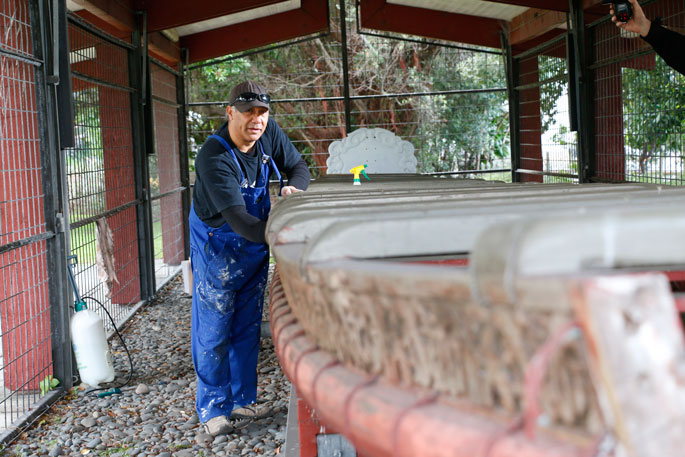It sits there, gathering dirt, dust, bird poop and the odd curious glance just where The Strand peters out.
‘Te Awanui', a proud and significant slice of city heritage, but off the beaten track, unannounced and largely ignored.
Te Awanui – the original name for Tauranga Harbour – is the city's very own ceremonial waka. A war canoe, 14m of sea-going objet d'art elaborately carved from a 300-year-old kauri tree.
It's quite a magnificent thing. 'And it's a wonderful piece of city history,” says Dean Flavell, Tauranga's cultural heritage manager. He's a man excited by who we are and where we came from.
'The waka's a symbol of a community, how two people, Maori and Pakeha came together.”
That's why the ‘manager' is today down and dirty in dungarees and plastic gloves, scrubbing, scouring and scraping at the elaborately carved gunwale running 46ft down one side of the waka and 46ft back up the other.
'It's my job to ensure the canoe survives, that the story endures.”
The story of Te Awanui is a grand, romantic and royal one. She didn't know it at the time, but Queen Elizabeth inspired Te Awanui. She was due Down Under in 1970 and when city fathers went looking for a waka to accompany the royal yacht Britannia to its berth, there wasn't one.
Necessity being the mother of invention, they decided to make one. But not quite in time for the Queen.
A perfect 24m kauri tree was found at Waitawheta in the hills of Waikino and Waihi. A deal was struck with Tane, the mythical Maori god of the forests; the Baker men of Katikati fired up the chainsaw and master carver Tuti Tukaokao sharpened his adze and chisels.
Kaumatua Bill Ohia uttered the immortal line –'A project for the people, both Maori and Pakeha.”
Then on a dull rainy day, a noonday tide, on February 10 1973 (a full 22 months after the ‘people's project' began), Te Awanui was placed in the water at Tauranga. People lined the harbour banks three deep, and in went the 30 paddles.
Up went the chant: 'Ka rere e, ka rere e, ka rere te pitau whakareia, te au o te moana ki Tuhua” (It moves, it glides, swifter and swifter, canoe of my mana, out towards the great sea of Tuhua).
One of those calling the chant that day, one of the 30 paddlers, was a bloke called Reg Tahu. Today, 42 years after that moment in history, Reg's son just happens by the waka.
He shares his story with Dean, who has just slapped another coat of primer on the prow of Te Awanui. Maintenance is ongoing.
'That was nice,” says Dean. 'But the community is rapidly changing so it's important the waka is retained.” He is doing his bit.
'If you don't protect wood you will lose it. Like a house – if you don't look after it, it deteriorates and you lose it.”
And yes, Dean assures me the waka is still operational. Wouldn't that be a sight? Thirty big strapping blokes with paddles flailing, the chant going up and the waka cutting through the tide off the Strand. That would give the tourists off the cruise liners a reason to stop in Tauranga.
So perhaps we could give Te Awanui the prominence it deserves. Take it, and Te Urunga, the shelter up the Strand. Centralise it where it can be seen, touched and appreciated – up the Strand where once, unforgivably, we considered putting another waka, a big white plastic monstrosity of one.
That was never going to happen, but this could. I am sure Dean would be chuffed with that.

